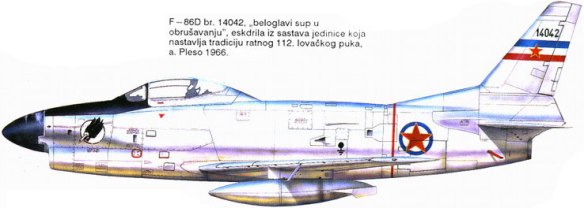During 1958-59, Yugoslavia’s air arm, the Jugoslovensko Ratno Vazduhoplovstvo (JRV), got 122 of the ex-RAF Sabre F.4s which had been returned to the USAF. Yugoslavia was one of the few nations with an air force that flew both Western and Soviet Bloc combat aircraft side-by-side. During a border incident in the late 1950s, a JRV Sabre shot down a Hungarian MiG-15.
One of many paradoxes of the post WWII Yugoslavia was being the only eastern European country that called itself communist, but wasn’t the part of Warsaw pact, and furthermore it was receiving western military support. Yugoslavia was called “east for the west, and west for the east”. On reflection, those grounds had the same role throughout history. Being on the crossroads did not bring much luck to its people.
As such, the Yugoslav Air Force in fifties, and sixties managed to paint red stars on some very advanced flying machines from the American inventory of the day. The last in the line of western fighter jets sent to Yugoslavia was F-86D, Sabre Dog. It remained in Yugoslav service until the 1970s, and for a while it flew together with MiG-21. This was a unique occurrence in the world.
The F-86D Sabre Dog was a development of the successful F-86 family. It was an interceptor, utilizing sophisticated radar equipment for tracking enemy targets (mainly strategic bomber formations). It was not designed for dogfights. The sole armament consisted of 24 unguided Mighty Mouse rockets. Pilot had a tough job of flying the aircraft, and aiming at the same time using its radar. After depressing the trigger imbedded algorithm determined the final moment for releasing the rockets.
As part of MAP arrangements, Yugoslavia was allocated a fleet of former Royal Air Force Canadair Sabre Mk. 4 aircraft, all modified to F-86E(M) standard with unslatted “6-3” wings.
Refurbishment was undertaken by a number of companies, at Stansted, Dunsfold, Gatwick, Speke and Merryfield. Deliveries began in May 1956 although substantial deliveries didn’t begin until May 1957 and by the end of that year some 37 Sabres were in service. By this stage, relations with the Soviet Union had improved and Yugoslavia announced that all military aid from the USA would end, and deliveries of Sabres ended with the 43rd aircraft.
However, the political situation soon changed and the US agreed to supply a further 78 former RAF Sabres in 1959, together with 130 former USAF F-86D aircraft. Some of the latter variants were modified in service to operate in the reconnaissance role (IF-86D), with three K-24 cameras replacing the standard Mighty Mouse rocket pack. The gradual development of an indigenous aircraft industry led to the introduction of the Galeb and Jastreb, and as these aircraft came into service the F-86E fleet was gradually withdrawn, the last examples being retired in 1971. The F-86D fleet remained in use until the end of 1974. Four F-86D aircraft were sold to Honduras during 1976.
